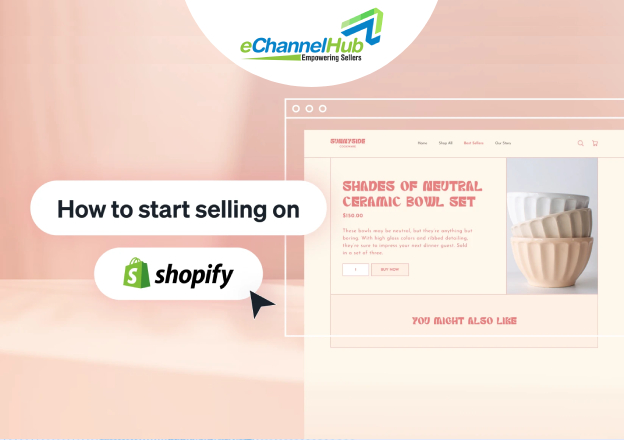How to Successfully Sell on Shopify: A Comprehensive Guide

Are you ready to take your eCommerce business to the next level? Selling on Shopify can be a game-changer for your online store. With its user-friendly platform and a wide range of features, Shopify makes it easy to create a professional and successful online business. But how do you ensure that you’re selling like a pro on Shopify? In this comprehensive guide, we’ll walk you through everything you need to know to maximize your sales and grow your business on Shopify.
1. Understanding the Difference Between Upselling and Cross-Selling
Before we dive into the strategies and best practices for selling on Shopify, it’s important to understand the difference between upselling and cross-selling. These two techniques are often used interchangeably, but they have distinct meanings and benefits.
Upselling:
Upselling is the practice of offering customers a higher-tier or more expensive product than the one they originally intended to purchase. For example, if a customer is looking at a basic laptop, you might offer them a more advanced model with additional features at a slightly higher price.
The key benefits of upselling are:
Increased average order value (AOV) by encouraging customers to spend more on higher-priced products.
Improved customer satisfaction by offering them a product that better meets their needs or desires.
Increased customer loyalty and repeat purchases, as customers perceive better value from the upsell and are more likely to trust your brand.
Cross-Selling:
Cross-selling, on the other hand, involves offering customers complementary or related products to the ones they are currently viewing or purchasing. For example, if a customer is buying a dress, you might suggest matching shoes or accessories to complete the outfit.
The key benefits of cross-selling are:
Increased average order value by encouraging customers to add additional products to their purchase.
Enhanced customer experience by providing them with convenient and relevant product recommendations.
Opportunity to introduce customers to new products they may not have considered otherwise.
While upselling and cross-selling are different techniques, they can be used together to maximize your sales and provide a comprehensive shopping experience for your customers.
2.How to Upsell and Cross-Sell on Shopify
Now that we understand the difference between upselling and cross-selling, let’s explore how to effectively implement these strategies on your Shopify store.
1. Upselling on Shopify:
Upselling is an effective way to increase your average order value and generate more revenue from each customer. Here are some strategies to successfully upsell on Shopify:
Quantity Tiers:
Consider offering quantity-based discounts to incentivize customers to buy more of a particular product. For example, you could offer a discount when customers buy two or more units of a product. This not only increases the value of their purchase but also encourages them to stock up on items they may need in the future.
Add-to-Cart Pop-ups:
Use pop-up notifications to offer upsells as customers add items to their cart. For example, if a customer adds a basic version of a product to their cart, you can display a pop-up suggesting an upgraded version with additional features. This strategy catches customers at the moment of purchase, increasing the likelihood of upselling success.
Product Upgrades:
If your products have different versions or tiers, consider offering upgrades to customers. For example, if you sell software, you could offer customers the option to upgrade to a premium version with more advanced features. Display these upsell options on the product page, in the cart, or at checkout to maximize visibility.
2. Cross-Selling on Shopify:
Cross-selling is a powerful technique to increase your revenue by suggesting complementary or related products to customers. Here are some strategies to effectively cross-sell on Shopify:
Customers Also Bought:
Display a “Customers Also Bought” section on your product pages, in the cart, or at checkout. This section suggests products that are commonly purchased together, increasing the chances of cross-selling success. Take inspiration from Amazon’s “Customers who bought this also bought” feature.
Popular Items:
Prominently display your best-selling products in strategic locations on your Shopify store. These popular items don’t have to be directly related to the products customers are currently browsing. As they are already proven best-sellers, they have a higher chance of appealing to a wide range of customers.
Personalized Recommendations:
Leverage customer data and browsing history to offer personalized product recommendations. Use Shopify’s built-in customer tracking and recommendation features to suggest products based on customers’ previous purchases or products currently in their cart. This personalization enhances the customer experience and increases the chances of cross-selling success.
3. Best Practices for Upselling and Cross-Selling on Shopify:
To ensure the success of your upselling and cross-selling strategies, here are some best practices to keep in mind:
Understand Your Customers:
Take the time to understand your target audience and their preferences. Analyze customer data, conduct surveys or interviews, and monitor customer feedback to gain insights into their needs and desires. This knowledge will help you tailor your upselling and cross-selling offers to their specific interests.
Choose Relevant Products:
When offering upsells or cross-sells, make sure the suggested products are relevant to the customer’s original purchase. The products should complement or enhance their current selection, providing them with additional value. Irrelevant or unrelated suggestions may confuse or annoy customers, leading to a negative shopping experience.
Highlight Benefits and Value:
Clearly communicate the benefits and value of the upsell or cross-sell offer to customers. Highlight how the additional product will enhance their experience or provide them with added value. This helps customers understand why the upsell or cross-sell is worth their consideration.
Provide Clear Pricing Information:
Be transparent about the pricing of upsell and cross-sell products. Clearly display the price difference between the original product and the upsell or cross-sell option. This transparency builds trust with customers and helps them make informed purchasing decisions.
Test and Optimize:
Continuously test different upselling and cross-selling strategies to identify what works best for your specific audience and products. Use A/B testing to compare different offers and monitor the results. Optimize your strategies based on customer feedback, purchase data, and conversion rates.
By following these best practices and tailoring your upselling and cross-selling strategies to your unique audience and products, you can drive increased sales and revenue on your Shopify store.
3. Finding Profitable Products to Sell on Shopify
Choosing the right products to sell on your Shopify store is crucial for success. Here are some profitable product ideas that you can consider:
-
Travel Accessories:
With the growing popularity of travel, offering travel accessories can be a profitable niche. Consider selling items such as travel bags, luggage organizers, portable chargers, and travel-sized toiletries. These products cater to the needs of travelers and can generate high demand.
-
Health and Beauty Products:
The health and beauty industry is thriving, making it a lucrative niche for online sellers. Consider offering products such as nutritional supplements, hair care products, eyelash accessories, and dental care items. These products cater to customers’ desire to look and feel their best.
-
Eco-Friendly Products:
As sustainability becomes a priority for many consumers, eco-friendly products are in high demand. Consider selling reusable and biodegradable items such as reusable straws, eco-friendly cleaning products, and sustainable fashion. These products appeal to environmentally conscious customers.
-
Vegan Products:
The vegan market is growing rapidly, providing opportunities for online sellers. Consider offering vegan nutritional supplements, organic beauty products, and cruelty-free clothing. These products cater to the needs of vegan consumers who prioritize ethical and sustainable choices.
-
Pet Accessories:
Pet owners are always looking for ways to enhance the well-being and appearance of their pets. Consider selling pet accessories such as pet beds, toys, grooming supplies, and personalized pet products. These products cater to a large and dedicated pet owner market.
-
Sports and Fitness Products:
With the increasing focus on health and fitness, sports and fitness products are in high demand. Consider offering items such as fitness equipment, workout gear, sports apparel, and accessories. These products cater to the needs of athletes and fitness enthusiasts.
-
Home and Garden Products:
Home and garden products are always in demand, providing a steady market for online sellers. Consider offering gardening tools, outdoor and indoor decor, and home improvement products. These products cater to homeowners and gardening enthusiasts.
-
Home Office Equipment:
As remote work becomes more prevalent, home office equipment is in high demand. Consider selling items such as ergonomic office chairs, standing desks, and productivity tools. These products cater to the needs of remote workers and individuals creating home office spaces.
-
Electronics:
The electronics market is constantly evolving and offers a wide range of products to sell. Consider offering gadgets, smart devices, gaming accessories, and home entertainment systems. These products cater to tech-savvy consumers who are always looking for the latest technology.
-
Smartphone Accessories:
With the widespread use of smartphones, smartphone accessories are in high demand. Consider selling phone cases, screen protectors, chargers, and Bluetooth accessories. These products cater to the needs of smartphone users who want to protect and personalize their devices.
-
Jewelry:
Jewelry is always a popular product category, providing opportunities for online sellers. Consider offering necklaces, earrings, bracelets, and rings. These products cater to fashion-conscious customers who want to accessorize and express their personal style.
-
Car and Bike Accessories:
Car and bike accessories are in high demand among vehicle owners. Consider selling items such as car phone holders, bike locks, car seat covers, and bike lights. These products cater to the needs of car and bike enthusiasts who want to enhance their vehicles.
By selecting a profitable niche and offering products that cater to the needs and interests of your target audience, you can increase your chances of success on Shopify.
- The Benefits of Selling on Shopify
Selling on Shopify offers numerous benefits that can help you establish and grow your online business. Here are some key advantages of using Shopify as your eCommerce platform:
Quick and Easy Setup:
Setting up an online store on Shopify is quick and easy, even for beginners. The platform provides user-friendly templates and a drag-and-drop interface, allowing you to create a professional-looking store without any coding or design skills.
Secure and Reliable:
Shopify takes care of server maintenance, security, and upgrades, ensuring that your online store is secure and reliable. The platform includes an SSL certificate, providing encrypted communication between your store and customers.
Customer Support:
Shopify offers 24/7 customer support to help you with any questions or issues you may encounter. Their dedicated support team is available via live chat, email, or phone, ensuring that you receive prompt assistance whenever you need it.
Mobile-Friendly:
With a growing number of customers shopping on mobile devices, it’s crucial to have a mobile-friendly online store. Shopify provides responsive themes and a mobile-optimized checkout process, ensuring a seamless experience for mobile shoppers.
App Integrations:
Shopify offers a wide range of apps and integrations that can enhance the functionality of your online store. From marketing and analytics tools to inventory management and shipping solutions, you can customize your store to meet your specific needs.
Payment Options:
Shopify supports various payment gateways, allowing you to offer multiple payment options to your customers. Shopify Payments, the platform’s built-in payment processor, provides a seamless checkout experience and simplifies payment management.
By leveraging these benefits and utilizing the features and resources provided by Shopify, you can create a successful and profitable online store.
- How to Find Profitable Niches for Your Online Business
Finding profitable niches is a crucial step in building a successful online business. Here are some strategies to help you identify profitable niches for your eCommerce store:
- Follow Your Passion:
Start by considering your own interests and passions. Building a business around something you’re passionate about can provide you with the motivation and enthusiasm needed for long-term success. Think about your hobbies, skills, and areas of expertise that you can leverage to create a unique and compelling online store.
- Research Market Trends:
Stay updated on current market trends and consumer preferences. Conduct market research to identify emerging niches and products that have high demand and growth potential. Use tools like Google Trends, social media listening, and industry reports to gain insights into market trends and customer behavior.
- Analyze Competitors:
Study your competitors to identify gaps in the market that you can fill. Look for niches or product categories that are underserved or have room for improvement. Analyze your competitors’ offerings, customer reviews, and pricing strategies to identify opportunities for differentiation and innovation.
- Identify Target Audience:
Define your target audience and understand their needs, preferences, and pain points. Conduct surveys, interviews, or focus groups to gather insights directly from your potential customers. Use this information to tailor your product offerings and marketing strategies to meet their specific needs and desires.
- Consider Profitability:
Evaluate the profitability of potential niches by considering factors such as product costs, profit margins, and competition. Research the selling prices and profit potential of similar products in your chosen niche. Calculate the costs involved in sourcing or producing the products, marketing expenses, and potential profit margins to ensure that your chosen niche is financially viable.
- Test and Refine:
Once you’ve identified a potential niche, test it by launching a small-scale pilot or MVP (Minimum Viable Product). Gather feedback from your initial customers and make necessary adjustments to your product offerings, marketing strategies, or target audience. Continuously monitor and refine your niche selection based on customer feedback, sales data, and market trends.
By following these strategies, you can identify profitable niches that align with your interests and have strong growth potential for your online business.
4. Conclusion
Selling on Shopify can be a lucrative venture if you approach it strategically and with the right products and techniques. By understanding the difference between upselling and cross-selling, implementing best practices, and offering products that cater to your target audience’s needs, you can maximize your sales and grow your business on Shopify. Remember to continuously research market trends, analyze competitors, and test different strategies to identify profitable niches and refine your product offerings. With the right approach and dedication, you can achieve success and profitability on Shopify.
Write For Us
Gain multichannel inventory visibility and control with eChannelHub
Learn more about eChannelHub with a free demo, tailored for your unique retail business.
Request A DemoRequest a Demo
Gain multichannel inventory visibility and control with eChannelHub
Learn more about eChannelHub with a free demo, tailored for your unique online business




